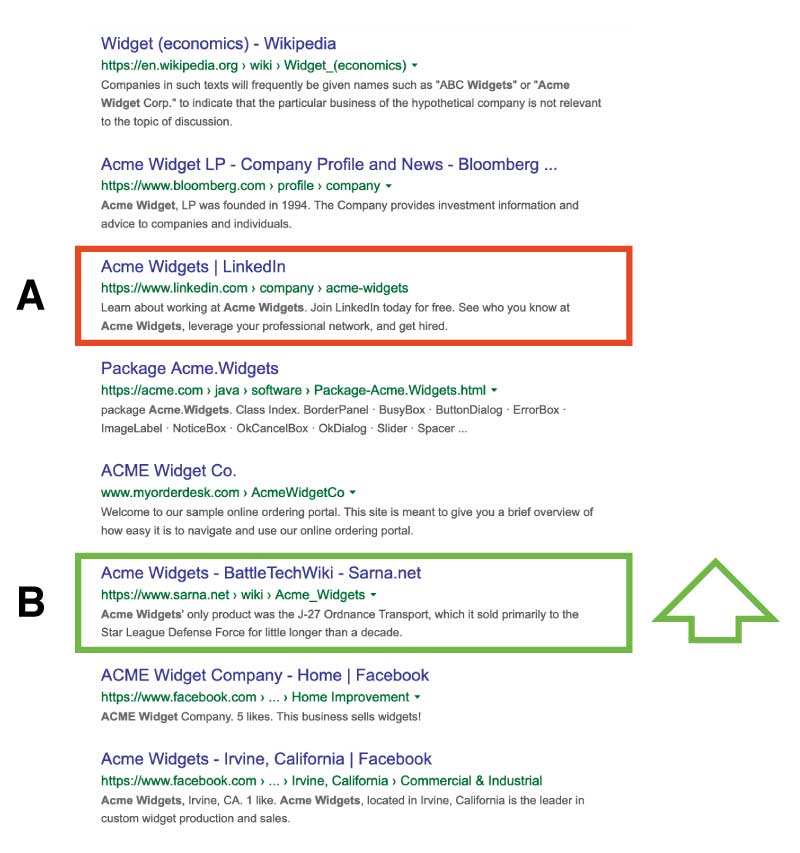Strategies for Optimizing Branded Online Content for Better Performance
A content suppression campaign works to reduce the visibility of negative articles that appear in search results. Many people ask how this type of reputation management campaign works. While many factors go into suppressing negative online content in search results, the existence of content that meets certain criteria, or lack thereof, makes all the difference. Here we discuss two scenarios and how to approach each.
There are two ways to approach content suppression campaigns. Either content exists that meets certain specifications, or it must be created.
Some content is meant to rank on the first pages of search results. Notice in the illustration below for a search for Acme Widget that almost all search results have the word “Acme” in the headline. Each site is relatively authoritative as well (discussed later as Domain Rating). This is content intended for first-page search results.
But most content is not meant to rank well and is instead intended to support the type of authoritative content mentioned above. This second type of content exists to promote the first because even authoritative content will not rank well unless promoted.
Optimizing existing positive content
In this scenario there already exists positive online content (See “B” in the example below) that occupies a position below the negative content (A). We want to move the existing positive content above the negative content.
In order to move B above A a few criteria must be met:
Positive content must be relevant
The positive content must be able to be made more relevant to the search than the negative content. Google and other search engines assign search ranking and visibility based on relevance to the users’ query. If a search result is above another
Positive content must be evergreen
The positive content must be “evergreen” in nature. It cannot be ephemeral or temporary in its relevancy. For example, a press release about an upcoming event may occupy a space high in search results for a time, but then fall back because it will not be as relevant in a few months. Wikipedia pages are an example of evergreen content – they will almost always be fresh and topically relevant. Many other types of content are also evergreen.
The positive content must be technically suitable
Technically suitable content performs better in search. For example, an article with the brand name in the article title will, in most cases, outperform articles that do not.
Technical aspects also encompass factors such as dwell time (how long a user spends on the page), search volume, bounce rate, and more. The positive content should appeal to a wide variety of interests. An article about a company that answers many related questions that users are asking will show up in more searches. For example, an article about company financials should answer many related questions as well, such as “What are the company revenues?”, “Is the company profitable?”, as well as regularly updated earnings information. An article that covers many facets of a query will perform better than one that covers only one aspect because more people will find the article useful. This will send signals to search engines that the content is valuable and can help it rank better for certain queries.
Hundreds of other technical factors also play a part, but one of the most important is the number of domains linking into the article and the relative level of “authority” on the topic each of those in-linking domains possesses.
Ideal content should be controllable by the brand
With so many factors going into what makes a page eligible for high visibility in search results it is quite helpful to have a page that is controlled by the brand. This is often different than a page on the brands’ flagship site because the company site will most often rank highly anyway.
For example, an article that doesn’t appear to be controlled by the brand but is, can be refreshed, tweaked, and optimized in ways non-controllable content cannot be. An article on Bloomberg cannot normally be changed. But an article on a third-party site that is amenable to modification of the content can be very helpful as different techniques can be used on the page over time to enhance its relevance for a specific group of search queries.
Scenario 2: No existing positive content
Sometimes there isn’t existing content that fulfills the above criteria. In this case, the content needs to be created. In this case, the same criteria as above should be observed (brand in the headline, relevant, evergreen, technically suitable, controllable), but the site upon which the content is placed should have a high authority.
Site authority is shorthand for a lot of technical factors, but two factors are most important:
- Topical relevance
- Domain rating
Topical relevance is a key factor
Topical relevance simply means the theme of the site should match that of the content and the industry the brand exists within. For example, let’s assume the subject of the article is a metal fabrication company. The ideal placement of content would be on an industry site with strong authority. One of the top authority sites in the space is The Fabricator, a site about all things related to that industry. That site is topically relevant to metal fabrication and would be an example of a good place to post content.
Domain rating is another strong factor
Another factor is the domain rating of the site. All websites are scored on a logarithmic scale of 0-100, with 100 being the strongest. Google is almost 100. Most sites are well below 30. Reputation X, which has a fairly good rating at 51, is strong for its industry.
Using the example above, The Fabricator has a Domain Rating (DR) of 74. That’s a very strong site and, along with topical relevance, makes it a good prospect for content placement that would rank well in search results.
Promotion of positive content to improve branded results
Both of the scenarios above will provide the relevant content needed to improve search results, but both will also require promotion to move the needle in search results.
Promotion with content
Promotion in this case usually entails the development of content on relevant publications in a similar way to that described in scenario two (new content) but with less focus on branded headlines and very high domain authority. This approach enables Reputation X to develop more content, links, and references for faster results using a special type of SEO.
Working with agencies
Reputation X doesn’t often publicly represent clients. Still, we often create content or cause it to be created and published by third parties. In the case of big publications like the New York Times or other well-known sites on which we would like to have our clients’ content posted, we often work with PR agencies who represent the client to target certain publications. In reality, the PR agencies are following a set of instructions provided by us as to targeting, content, and structure.
Changes to controlled web properties
We will also make changes to client websites, social properties, and third-party sites intended to channel some of their authority toward sites and content we predict will rank for our clients’ search phrases with the proper incentive.
This is a multi-phase content engineering and refresh program where we direct our clients’ webmasters and content creators to make adjustments to the way they create content. We also make suggestions for changes to existing content they already host on their main site and others they control.
These changes can make a good early difference in how Google treats a brand in search results because the sites are already authoritative and often need basic optimization to shine.
Which is best for reputation management?
Which solution is best? The best solution would be the first (existing positive content) because the relevant and authoritative site already exists. It’s faster and less costly for our clients.
Development of a new site to rank on page one is far more resource intensive than using an existing property – so long as it meets the criteria mentioned above.
An online reputation management program often develops new content and then promotes it, as well as augmenting existing positive content to rank better for the target search terms.
FAQs
What is content suppression?
A content suppression campaign works to reduce the visibility of negative articles that appear in search results.
How can I move positive content above negative content in search results?
Positive content must be relevant. Positive content must be evergreen. The positive content must be technically suitable. Ideal content should be controllable by the brand.
What is site authority?
Site authority is shorthand for a lot of technical factors, but two factors are most important. 1. Topical relevance. 2. Domain rating.
What is topical relevance?
Topical relevance simply means the theme of the site should match that of the content and the industry the brand exists within. For example, let’s assume the subject of the article is a metal fabrication company. The ideal placement of content would be on an industry site with strong authority.
What is domain rating?
All websites are scored on a logarithmic scale of 0-100, with 100 being the strongest. Google is almost 100. Most sites are well below 30. Reputation X has a fairly good rating of 72 and is strong for its industry.
About the author
Kent Campbell is the chief strategist for Reputation X, an award-winning reputation management agency based in California. Kent has over 15 years of experience with SEO reputation management, Wikipedia editing, review management, and strategy. Kent has helped celebrities, leaders, executives, and marketing professionals improve the way they are seen online. Kent writes about reputation, SEO, Wikipedia, and PR-related topics and is an expert witness for reputation-related legal matters. You can find Kent’s biography here.
–


